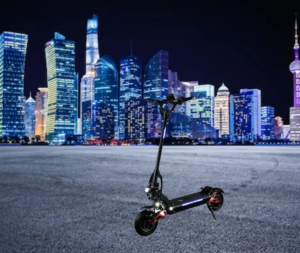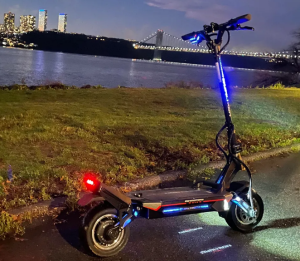Scooters often lack ABS due to cost concerns, size limitations, and market expectations for low-speed, urban use.
Scooters and Safety
Importance of Safety Features in Scooters
Having safety features in scooters can make a significant difference, not only to protect the rider, but also to make it safer for everyone else on the road. The design and integration of these technologies can reduce the potential for collisions and the impact of other incidents, lessening the severity of injuries that occur. For instance, Anti-lock Braking Systems (ABS) works to prevent the wheels from locking, reducing the chances of skidding after a hard brake. A study found that, in countries where ABS without combined braking was mandatory, they were able to reduce the risk of a scooter being involved in a frontal collision by 37 percent when compared to units without.
Retro-reflective materials and enhanced lighting can also play a substantial role, at any time of day, but particularly as the sun goes down. A report from the National Highway Traffic Safety Administration found that a motorcycle with running head and tail lights (a filament light, not a daylight running lamp) is viewable from 300 feet, roughly a tenth of a mile. When those lights are upgraded with optimized visibility, a high-mounted running light, an auto-ignition switch and appropriate retro-reflective material, a following driver can spot the rider from 1,000 feet, which is nearly a third of a mile away. At 55 mph, you’d need nearly two more seconds to come to a safe stop. That’s critical in areas with low illumination. A DOT study found that scooters with improved visual lights were seen at a distance 30 percent greater than those with standard headlights; in the few seconds before an accident, improved lighting and visibility reduces the chances of another car turning in front of the rider.
Common Causes of Scooter Accidents
Lack of Visibility: A large number of scooter accidents occur as a result of other drivers failing to see the scooter, particularly at night. Incorporating bright, LED lighting while also adding reflective material to equipment could increase visibility by 50%.
Speeding: One of the main causes of accidents to severity is through exceeding speed limits. Each 10 km/h over increases the risk of accident by 2.
Inexperienced Riders: New riders invariably are more accident-prone as a result of the unfamiliar dynamics of their scooters; advanced training courses could mean accident rates as much as dropping 20% among new riders.
Poor Road Conditions: Potholes, wet roads and other irregularities are a significant hazzard; additional potholes in urban areas could mean a 25% reduction in scooter accidents.
In summary, making some significant changes to scooter safety features and addressing some of the more common accidents could mean a very different picture when we compare 2022 to 2017. It’s remotely possible that the Los Angeles of 2022 might even have fewer scooter related fatalities then the 2 of 2017. It is not out of the question with better technology and more awareness.
Technical Challenges of Implementing ABS in Scooters
Size and Weight Considerations
It is not simple to integrate ABS into scooters, Adrian explained, because they are small and have limited weight capacity. The vehicles are designed to be lightweight and compact, meaning there is not much additional equipment they can carry without compromising performance. An ABS system, which typically includes sensors, a control unit and hydraulics, can add around 1.5 to 2.5 kilograms to a scooter’s weight. This may not sound like much, but if a scooter weighs around 100 kilograms, it means a 2.5 percent increase in total weight.
In addition, there is little room under scooters’ seat for new components. In order to fit an ABS system onto these vehicles, space needs to be found without clashing with the existing mechanics and without encroaching on the rider’s space. Here, engineers are challenged to miniaturize ABS components without loosing any efficiency or reliability. Miniaturization means these components become more expensive to produce, as precision engineering and high-quality materials are required.
Cost Implications
The addition of an ABS system to a scooter has a substantial effect on its final price. The specific cost of an ABS system can vary, but in general, adding ABS to each scooter will tack $200 to $400 onto its manufacturing cost. When these increased costs are passed onto consumers, scooters become less affordable overall, which is especially problematic in markets where high price sensitivity exists.
Manufacturing gets more complicated with ABS, too. The need for extra testing and quality control ensures the system is reliable adds a bit of complexity to the production process, as well. This extra time and expense increase the scooter’s final price beyond what the ABS hardware itself adds.
For scooter manufacturers, adding ABS to a scooter involves a game of finding the safety improvements that ABS brings worth the cost. While adding ABS can go a long way towards keeping a rider upright during a sudden stop, the increased cost of a scooter might also push away many buyers, particularly in places where shoppers are more concerned with the cost of a scooter than its advanced safety features.
Adding ABS to scooters comes with an ongoing cost to consumers, too. As with ABS in other vehicles, scooter ABS systems will require the occasional checks and service to maintain their effectiveness. This extra maintenance requirement drives up the total cost of ownership, making scooters with ABS even less appealing to someone who’s watching every penny.
ABS in Motorcycles vs. Scooters
Differences in Vehicle Dynamics
The distinct designs and handling characteristics of motorcycles and scooters mean that ABS must be implemented differently. Motorcycles generally have higher power-to-weight ratios, which permit faster acceleration and higher top speeds. This requires a more robust ABS, capable of quickly fine-tuning braking for higher-speed stopping without fear of sliding. Scooters, by contrast, are made for lower-speed urban commuting, which requires an ABS system optimized for frequent full stops and starts in traffic.
Motorcycles also typically feature larger, more complex braking systems than scooters. These bigger and more complicated motorcycle brakes allows for more effective dissipation of the heat generated under braking, which is critical for ABS performance. With their smaller wheels and lighter weight, scooters demand an ABS that adjusts to these differences and still enables the vehicle to stop quickly when needed, without sliding, while not adding significant cost or weight to the already cheap form of transportation.
Then, there is the issue of dynamic weight distribution during braking, which is often more pronounced in motorcycles, thanks to the more significant shift to the front wheel under hard braking than in a scooter, which sees a more balanced weight distribution. This difference also means the characteristics of those two ABS systems must also be very finely tuned for each vehicle to ensure there is no wheel lock-up while the rider retains full maneuverability.
Adoption Rates and Industry Standards
Motorcycles have seen higher adoption of ABS than scooters, partly due to regulatory requirements and market expectations. Many regions mandate that motorcycles above a certain displacement must have ABS. The European Union, for example, requires all new motorcycles with an engine displacement over 125cc to have ABS. The adoption of ABS in motorcycles has quickly approached 100% in territories where this rule is enforced.
Conversely, scooters have seen slower ABS adoption, with many models not featuring this technology. The slower growth can be attributed to several reasons, including lower-power scooters being used primarily for short trips within cities, discerning fewer benefits of ABS and budget sensitivity among scooter buyers. However, some studies show that the adoption of ABS in scooters can result in accident reductions of up to 29%, emphasizing the benefits of broader ABS adoption.
Industry standards play a major role in the adoption of ABS. Partly because of a culture revolving around performance and safety, motorcycles are usually subject to more stringent safety regulations than scooters. The scooter market is much more varied, featuring products aimed at different segments, such as budget commuters and luxury models, among others. However, consumers and the industry are starting to realize the value of ABS in terms of safety, with industry standards and consumer expectations of safety in scooters both slowly changing and increasing.
Current Solutions and Alternatives to ABS for Scooters
Mechanical Brake Enhancements
The primary solution to improving scooter safety in the absence of ABS involves enhancing the mechanical components of the braking system.
A higher-friction brake pad and a larger brake disc make for more stopping power and reduce stopping distances. Higher-friction brake pads are made to offer a better grip which can decrease braking distance by as much as 10% in comparison to what standard pads provide.
Another technology that’s proved invaluable is CBS (combined braking systems) which link the front and rear brakes together allowing for more even distribution of the braking force between the two wheels. It reduces stopping distances by as much as 20% in comparison to traditional independent braking systems. The result is greatly enhanced safety, particularly in hard braking conditions.
Electronic Stability Programs
For scooters, Electronic Stability Programs (ESP) offer an alternative to ABS by helping to maintain stability during sudden maneuvers or in slippery conditions, using systems that monitor vehicle dynamics such as wheel speed, lean angle, and acceleration. These automatically apply the brakes or modulate engine power when potential loss of control is detected. While not a direct substitute for ABS, this can be an effective complement to mechanical brake enhancements to provide that extra layer of safety. In some studies, it has been shown to reduce the probability of accidents by 25 percent by increasing vehicle stability during critical maneuvers on the scooter.
This innovation is also helping to open the door for additional safety systems on scooters in the future, such as adaptive cruise control and collision avoidance using similar sensor and control technology. Despite the potential benefits, ESP has been slowly making its way onto scooters in part due to the cost of its inclusion, and in part because additional markets are still “getting ready” to accept it.
Why don't all scooters have ABS?
How does ABS improve scooter safety?
What are alternatives to ABS for scooters?
Can scooters be retrofitted with ABS?


